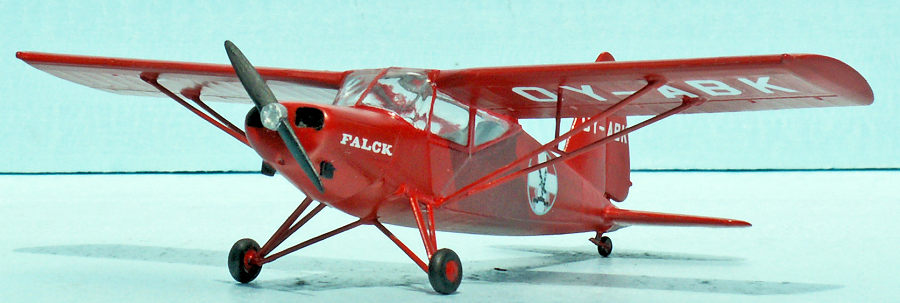
Stoppel 1/72 Kramme and Zeuthen KZ-VII Lark
| KIT #: | 697217 |
| PRICE: | $20.00 |
| DECALS: | Two options |
| REVIEWER: | Torben Plesberg |
| NOTES: | Standard build and KZ III conversion |

Skandinavisk Aero Industri (SAI) had designed and built some light sporting planes in the late thirties. The first of these, the KZ I was a single seat low wing sporting plane with a modest 2 cylinder boxer engine with an output of 38 hp. It flew for the first time on February 24 1937. KZ is an abbreviation of the persons, who were responsible for the aircraft: Viggo Kramme, who had a repair shop for aircraft at Kastrup Airport, and Karl Gustav Zeuthen, who was an engineer. The KZ I was test flown and got its CA and the registration OY-DYL.
However, there was no interest in this small nice plane, and Kramme and Zeuthen worked intensively with a larger two seat sporting plane: the KZ II. The design of this plane might have been inspired by the design of the Miles Magister. The KZ II had roughly the same dimensions, and using the same engine as the Magister, De Havilland Gipsy Major 1, it had a similar performance. There were three different KZ II: The KZ II Sport, the KZ II T (trainer) and the KZ II kupé.
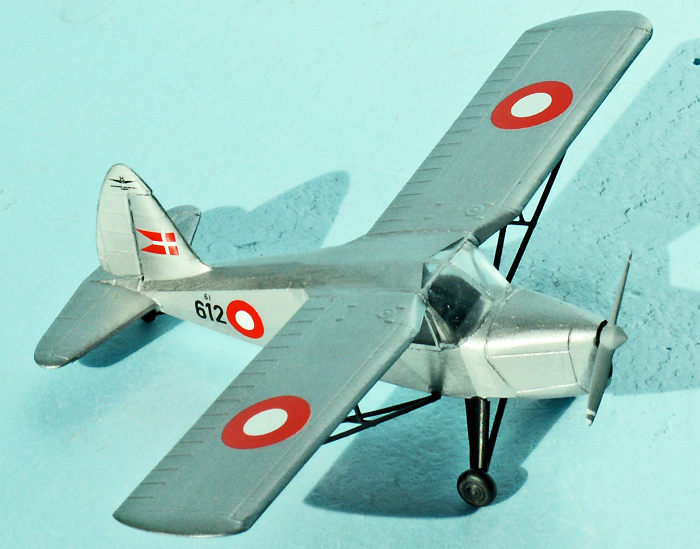 The Kupé appeared late
in 1937, and was a low wing monoplane for two persons placed side by side in a
closed cockpit. It was powered by either a Cirrus or a Gipsy Minor engine with
an output of 90 hp. Fourteen aircraft were produced until 1944. The Germans
“organized” (i.e. stole) most of the aircraft. What actually happened to these
aircraft, is not known. However, three KZ II Kupé are flying to day, two in
Denmark and one in Switzerland.
The Kupé appeared late
in 1937, and was a low wing monoplane for two persons placed side by side in a
closed cockpit. It was powered by either a Cirrus or a Gipsy Minor engine with
an output of 90 hp. Fourteen aircraft were produced until 1944. The Germans
“organized” (i.e. stole) most of the aircraft. What actually happened to these
aircraft, is not known. However, three KZ II Kupé are flying to day, two in
Denmark and one in Switzerland.
The Sport was also a low wing monoplane, however with two seats in tandem in an open cockpit. Behind the rear seat, there was a hump on the top of the fuselage, characteristic for the Sport model. This model appeared in 1938. It was powered by a Hirth 504A with an output of 105 hp. Sixteen aircraft were produced. The Danish Navy ordered four Sports, however the Germans organized all of these. Only one Sport exists today, and will probably never get airborne again, just restored for exhibition.
The KZ II T is a strengthened version of the Sport, and powered by a 135 hp Gipsy Major I, or a 145 hp Gipsy Major X. The prototype was built, and flew for the first time in 1946. It was a tandem two-seat trainer with an enclosed cockpit and a canopy sliding rearwards, just like the De Havilland Chipmunk. The fifteen production aircraft had, however, like the sport an open cockpit. All of the aircraft were delivered to the Danish Air Force, and they served with the flying school at Avnø until 1955. Six aircraft were lost, and the surviving nine aircraft were sold on the civil market in Denmark. Two of these are still flying, and another three will be restored to flying condition.
After the German occupation in 1940, the SAI had to stop their aircraft production, and the Germans ordered the firm to work for the German Aero Industry. According to German authorities, the products of SAI were not good enough, according to German standards. The poor quality might have been intentional! Viggo Kramme was sent to Germany, where he learned a lot about the Fieseler Fi 156 Storch. This knowledge of the wing construction was very useful, when the ambulance plane KZ III was designed, as well as the KZ VII, a four-seat variant of the KZ III.
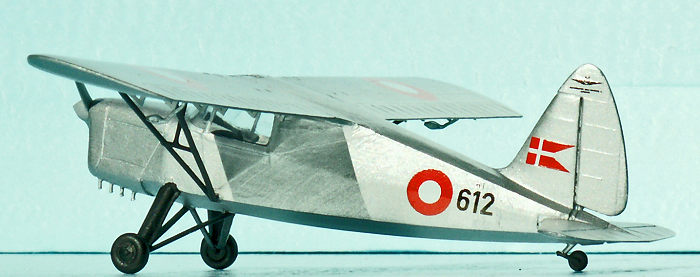 Actually, the SAI got
German permission to build the KZ III ambulance plane, which flew for the first
time in 1944 - in Sweden. The Germans gave furthermore permission to build a
twin-engine ambulance plane – the KZ IV - and this plane was ready to fly on May
4 1944. After the war, the KZ VII was finished, and flew for the first time
October 11 1946. It had the same STOL characteristics as the KZ III, the landing
speed being only 55 km/h = 34 mph. There is a story from Switzerland, concerning
an airfield, where both a KZ III and a Fieseler Storch were stationed. Someone
would like to know, which of the planes was the slower in the air. A contest was
set up, and the KZ III won! Therefore, the Swiss call the KZ III “the Danish
Storch”. Viggo Kramme did a good job, when he was in Germany, studying the
Fieseler Storch.
Actually, the SAI got
German permission to build the KZ III ambulance plane, which flew for the first
time in 1944 - in Sweden. The Germans gave furthermore permission to build a
twin-engine ambulance plane – the KZ IV - and this plane was ready to fly on May
4 1944. After the war, the KZ VII was finished, and flew for the first time
October 11 1946. It had the same STOL characteristics as the KZ III, the landing
speed being only 55 km/h = 34 mph. There is a story from Switzerland, concerning
an airfield, where both a KZ III and a Fieseler Storch were stationed. Someone
would like to know, which of the planes was the slower in the air. A contest was
set up, and the KZ III won! Therefore, the Swiss call the KZ III “the Danish
Storch”. Viggo Kramme did a good job, when he was in Germany, studying the
Fieseler Storch.
The SAI built four KZ III ambulances with a door for the stretcher in the port side, and the patient would lie with his head close to the instrument panel. Two KZ III were delivered to the army as liaison planes. In 1950 Flyvevåbnet (the Royal Danish Air Force) was founded as an independent arm of the Danish defense. The two KZ III ( 611 and 612, code for aircraft type: 61) got a very short service life within Flyvevåbnet, since they were phased out in 1951 - and sold on the civil market.
All together 64 KZ III were built in 1946, and at least 19 are still on the Danish register as airworthy planes. There are two in Germany, five in Sweden, one in Iceland and two in the USA. The KZ III with its 100 hp Cirrus Minor engine is easy to fly and beloved by its pilots. One of the old no longer registered KZ III, was restored by a veteran group and painted as one of the Aircraft of Flyvevåbnet. However, since this particular aircraft never was in the armed forces, it was allocated the fake number “613”!
The four- seat version, the KZ VII was built between 1947 and 1954. Sadly, a fierce fire destroyed the factory in February 1947 and 22 finished airframes went up in flames. The engines -125 HP Continental boxer engines – were luckily stored another place, and production was resumed. However, because of the special Danish import/export regulations after the war, it was not possible to get the necessary foreign currency permissions, and the production slowed down. SAI assembled thirty aircraft in the following years, and the production ended in 1954, with 56 planes built, all together.
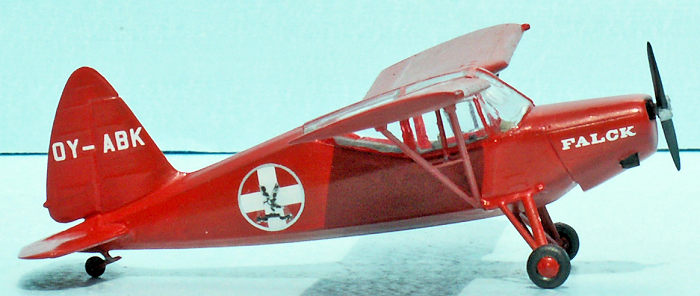 The KZ VII had many
components in common with the KZ III, fuselage and wings are almost identical.
The major difference between the two aircraft is the engine, the Continental
boxer engine for the KZ VII, and the Cirrus Minor II in line for the KZ III. The
most important user of the KZ VII was the Danish Air Force, Flyvevåbnet, which
operated 10 aircraft from 1950 to 1977 as a school plane and for general
purposes. The flying school at Avnø got the 10 aircraft already in 1948. From
before the war, the flying school had operated the KZ II, a well suited trainer,
because it was difficult to fly. The KZ VII was too easy to fly, and from 1950,
the British build Chipmunk started to replace the few remaining KZ IIs and the
KZ VIIs.
The KZ VII had many
components in common with the KZ III, fuselage and wings are almost identical.
The major difference between the two aircraft is the engine, the Continental
boxer engine for the KZ VII, and the Cirrus Minor II in line for the KZ III. The
most important user of the KZ VII was the Danish Air Force, Flyvevåbnet, which
operated 10 aircraft from 1950 to 1977 as a school plane and for general
purposes. The flying school at Avnø got the 10 aircraft already in 1948. From
before the war, the flying school had operated the KZ II, a well suited trainer,
because it was difficult to fly. The KZ VII was too easy to fly, and from 1950,
the British build Chipmunk started to replace the few remaining KZ IIs and the
KZ VIIs.
Flyvevåbnet transferred the KZ VIIs to station flights of the air bases to do service as liaison planes. There were no accidents with the KZ VII during its 29 years of service time. However, two aircraft were lost to hangar fires, and one aircraft ditched in the sea, and was later scrapped. Salt water is no good for the steel tubing of the airframe.
Some of the ex. military KZ VIIs are still flying, and there are 20 KZ VIIs on the Danish register at present. In Finland and Switzerland there are still KZ VIIs flying, in Finland on floats and in Switzerland with a ski undercarriage. The “Danish Storch” is very popular in Switzerland, thanks to its STOL characteristics.
The KZ VII was also
used by several flying schools. Most notable of these was Morian Hansens
Flyveskole at Skovlunde airfield. Morian was a RAF fighter pilot during the war,
flying Spitfires in the Far East. He was the hig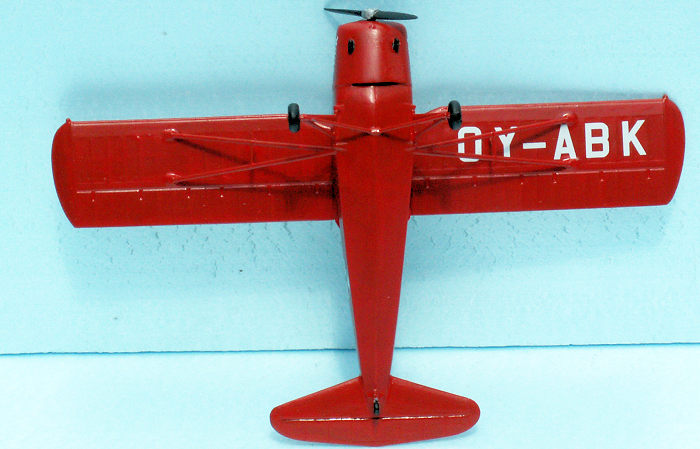 hest decorated Danish pilot with
a DFC and a George Cross. His private plane was a Messerschmitt Bf 108, which he
“organized” just after the end of the German occupation of Denmark. The Germans
left more than 1100 warplanes in Denmark, all of these were destroyed by British
troops – with one exception! Morian’s real name was Jens Henning Hansen. He
earned his nick name as a dirt track driver: after a race his head was all black
with dirt!
hest decorated Danish pilot with
a DFC and a George Cross. His private plane was a Messerschmitt Bf 108, which he
“organized” just after the end of the German occupation of Denmark. The Germans
left more than 1100 warplanes in Denmark, all of these were destroyed by British
troops – with one exception! Morian’s real name was Jens Henning Hansen. He
earned his nick name as a dirt track driver: after a race his head was all black
with dirt!
The final variant of the KZ III was the KZ X. It was designed as a forward controller aircraft for the army. It was two seated with the seats in tandem, and the fuselage was 20 cm narrower than the KZ III. The KZ X was powered by a 145 HP Lycoming boxer engine. The glazing above the cockpit was rounded upwards, and the visibility was excellent. However, this aircraft type suffered some accidents, killing the pilot and observer. A KZ X was shipped to Farnborough in order to find the cause of the accidents. However, this aircraft also crashed, and the Danish Army gave up the type. All remaining aircraft were scrapped, and the engines were transferred to the KZ VIIs. SAI strengthened the still existing prototype and enlarged the fin. After this modification, the aircraft was perfectly safe to fly- and it is still flying to day as KZ X Mk 2 and registered OY-AOL.
| THE KIT |
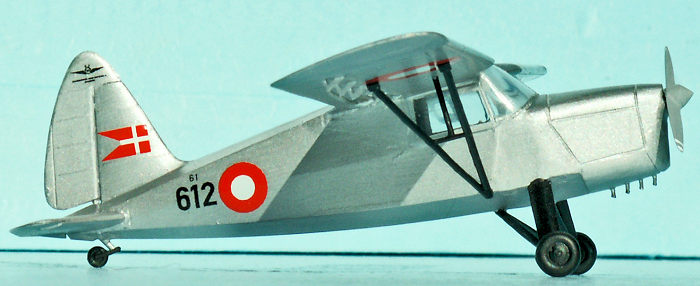 The
kit comes in a nice
small box with a photo of a military KZ VII on the lid and in the bottom. The
box opens in the end, and is therefore not fit for keeping the parts during the
construction process. The instructions is six small pages. Page one shows the
parts of the kit, including transparent parts (canopy and landing light). There
are three different propellers with the kit for different purposes. The parts
are nice and without flash. Pages two to six show in 10 steps how to put the
model together, step 10 being the choice of propeller. The decal sheet has two
options: A military plane of flyvevåbnet 0-620/21 and an air ambulance in the
color scheme of Falck’s Flyvetjeneste (Air Services) OY-ABK. The printing
quality is first class and the decals are easy to apply.
The
kit comes in a nice
small box with a photo of a military KZ VII on the lid and in the bottom. The
box opens in the end, and is therefore not fit for keeping the parts during the
construction process. The instructions is six small pages. Page one shows the
parts of the kit, including transparent parts (canopy and landing light). There
are three different propellers with the kit for different purposes. The parts
are nice and without flash. Pages two to six show in 10 steps how to put the
model together, step 10 being the choice of propeller. The decal sheet has two
options: A military plane of flyvevåbnet 0-620/21 and an air ambulance in the
color scheme of Falck’s Flyvetjeneste (Air Services) OY-ABK. The printing
quality is first class and the decals are easy to apply.
| CONSTRUCTION |
If you follow the
instructions, you will end up with a nice model of a very special plane. It is a
small model, however, it is very accurate and there is no need to change
anything. The two canopy parts are not exactly symmetrical on the roof, and need
some sanding. The most difficult item during the construction is to separate the
very thin wing supports from the sprues – without cracking anything! A beginner
cannot do this, an experienced modeler only with the outmost care. Think
thoroughly about in what order to cut the parts, to avoid mishaps. In my first
try, I had two mishaps! In my second try, I had learned how to it properly. A
photo etched saw blade can do the job in a safe way, according to my son
Nicolai. Another delicate job is gluing the two canopy halves together without
too much excessive glue on the front or in the roof. I used some clear
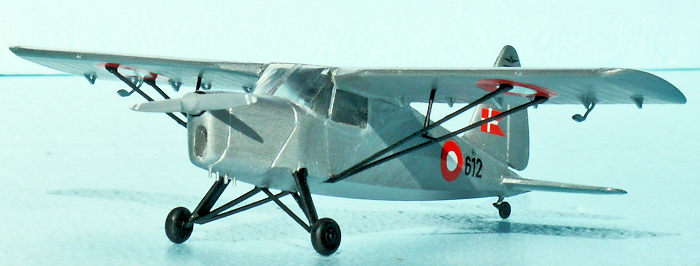 varnish
as glue, and afterwards both inner and outer side got an extra layer of varnish
to strengthen the construction.
varnish
as glue, and afterwards both inner and outer side got an extra layer of varnish
to strengthen the construction.
The most difficult part to glue in place was part no 9 – the top of the instrument panel. The two small holes in this part are for some structural tubing. However, there should be four of them, even if the “inner tubing” of the cockpit is not with the kit. If the scale was 1/48 or bigger, I would have taken the trouble to make the inner tubing behind the front glazing. In this small scale – forget it and fill the holes!
When gluing the wings to the clear canopy, be sure that the slots for the wings are thoroughly cleaned up. The wings should be easy to push in place. Be sure to get the dihedral right. The instructions does not show the dihedral, it should be two thirds of the thickness of the wing. The wing supports fit precisely into the two holes in the lower wing halves, however the angled end must be cut precisely to fit the fastening points of the fuselage. The undercarriage legs (B7+8) fit nicely to the underside of the fuselage, and likewise the support (B9). The landing light is placed in the lower hole of the cowling front – not shown in the instructions!
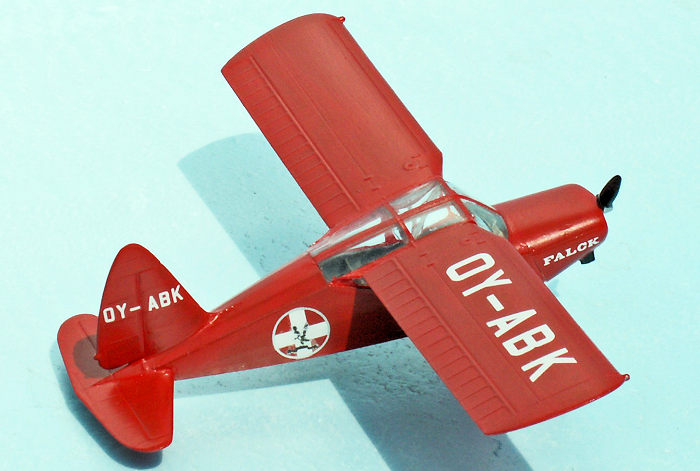 KZ III conversion: It
is possible to create a KZ III from the KZ VII kit. You need to produce a new
engine cowling for the Cirrus Minor in line engine. I made this from a small
block of Ureol (artificial wood). Most important is the correct position of the
propeller shaft and the air intake of the engine. The correct shape of the
cowling depends on these positions. The main undercarriage support must be
modified for the KZ III. The canopy is smaller. The large triangular window to
the rear, must be filled and sanded away, likewise most of the glazing of the
roof to the rear.
KZ III conversion: It
is possible to create a KZ III from the KZ VII kit. You need to produce a new
engine cowling for the Cirrus Minor in line engine. I made this from a small
block of Ureol (artificial wood). Most important is the correct position of the
propeller shaft and the air intake of the engine. The correct shape of the
cowling depends on these positions. The main undercarriage support must be
modified for the KZ III. The canopy is smaller. The large triangular window to
the rear, must be filled and sanded away, likewise most of the glazing of the
roof to the rear.
On the underside of the wings, the KZ VII kit has a row of small slots for the hinges of the ailerons and flaps. I took the trouble to make these hinges, and the mass balances for a more realistic look. The undersides of the wings looked too bare without these items! With the engine cowling in place in the front of the fuselage, and the shaping was finished, I scribed the lines for the cowling hatches with a triangular needle file. Finally, four holes were drilled on the underside of the cowling for the short exhaust pipes of the in line engine. The pipes are 0.5 mm gauge brass tubing.
| COLORS & MARKINGS |
The color scheme of the
Falck’s air ambulance is red over all, Revell 31 fire red Aqua gloss. The
propeller is black with yellow tips. The exhausts are also black. The tires are
rubber black, and the tail wheel assembly is
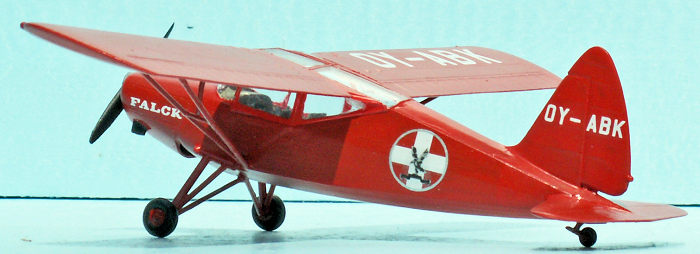 all black. The large registration
letters of the decal sheet are from the early days after the war, and the
smaller ones are from the late career of the aircraft. If the large letters are
applied, it is necessary to put them on before the wing supports are glued in
place. The large Falck’s logo on the fuselage sides must be applied in two
tempi. Likewise the Falck’s Flyvetjeneste marking on the cowling. After
decaling, the whole aircraft got a layer of Satin Cote to protect the decals and
provide a nice finish.
all black. The large registration
letters of the decal sheet are from the early days after the war, and the
smaller ones are from the late career of the aircraft. If the large letters are
applied, it is necessary to put them on before the wing supports are glued in
place. The large Falck’s logo on the fuselage sides must be applied in two
tempi. Likewise the Falck’s Flyvetjeneste marking on the cowling. After
decaling, the whole aircraft got a layer of Satin Cote to protect the decals and
provide a nice finish.
The color scheme of a KZ III from Flyvevåbnet is aluminium all over, Revell Aqua 99. Wing struts and undercarriage are black. Propeller is light grey HB 166, with two narrow white stripes on the tips. The decals are from a Stoppel sheet with Danish national roundels. The 612 and the very small 61 were from my decal stocks. The KZ logo on the fin was from another Stoppel KZ VII kit (697273).
| CONCLUSIONS |
Jacob Stoppel has produced a nice little short run kit. It is not recommendable for beginners, however any experienced modeler might take up the challenge to create a nice model of this unique Danish aircraft from the late forties. The Danish Storch! There are five more kits in the range. The difference is mostly with the decal sheets. There are four options with each kit. One of the kits (697271) have extra sprues with floats and ski undercarriage.
| REFERENCES |
Several articles on the SAI aircraft from the internet, and from the Quarterly of the Aviation Historical Society (Flyvehistorisk Tidsskrift)
My collection of photos of the KZ VII and KZ III from 1961 to the present day.
3 December 2019
Copyright ModelingMadness.com
If you would like your product reviewed fairly and fairly quickly, please contact the editor or see other details in the Note to Contributors.
Back to the Main Page Back to the Previews Index Page Back to the Review Index Page